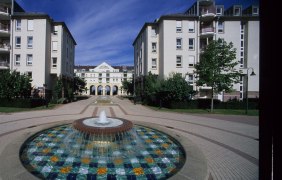History and construction
Around 1350, the city walls first erected in the 3rd century CE were rebuilt. The new fortifications enclosed a much smaller area, while the Roman theatre, the former Roman garrison, and other important quarters were outside the city. The stones of the Roman buildings were reused to erect the new wall, while the Roman road leading to the former Porta Praetoria continued to serve as a thoroughfare. To facilitate this, a new gate had to be built in the new wall where the original Roman diagonal pavement in red sandstone is still visible.
Location and current state
The Roman Gate is located in Mainz-Oberstadt at Kästrich near Kästrich 61. The gate, the adjacent sections of the wall, and the Roman road were excavated in 1985. On the Via Praetoria, grooves left behind by Roman vehicles are still clearly visible. They are about 2 m apart, indicating the width of Roman carriages and they show that the Via Praetoria was a well-travelled road. The Roman Gate was discovered during construction work for a new residential block at Kästrich. The gate was subsequently incorporated into the new development and is accessible to the public. As the remains of the double city wall and the gate were located around 3 m below today's street level, visitors need to walk down two stairs to reach them.
Only two side pillars of the Roman Gate have survived, which were also the only remains of such a structure ever found in Mainz as well as one of the latest such gates in Germany.
Near the Roman Gate, there is the medieval Alexanderturm, which is believed to have been built on the foundations of one of the many Roman towers that guarded the city wall.

searchMenu


